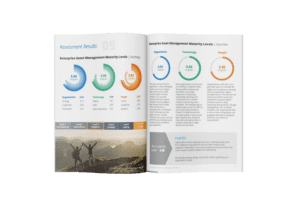Just in case.
Do you ever stop and think about all the preparations we do just in case something unexpected happens?
Say your car transmission blows up.
Now, you need a tow truck, a mechanic, and your insurance agent to get mobile again. Hopefully, your insurance covers some of the costs, but you still missed whatever you were driving to.
It would be much easier if your car could just see the issue coming and let you know, right?
You’d have time to plan. Time to budget.
You could be proactive rather than reactive.
Proactive Utilities
In this new day of AI and big data, many utilities are investing in advanced data and analytics.
But it’s not just to acquire more technology. It’s about using that technology, harnessing the data, and implementing advanced analytics to help decision-makers improve your business with increased efficiency.
And getting to the point where you can work proactively rather than reactively.
Getting the Baseline
Before you can improve, you have to know where you stand. Start by understanding your organization’s current analytical capabilities.
Having a clear, objective view of your position helps you know where to focus efforts to improve and lets you benchmark against competitors.
This is where Rizing’s Enterprise Asset Management (EAM) Technology and Analytics Maturity Assessment (TAMA) comes in handy.
What We Don’t Do
We could use AI to create laundry lists of analytics and the benefits they provide for utility companies. We could link those analytics to technology products and map metrics to the data collected.
But that doesn’t mean we really understand your organization.
To get that deep understanding, most companies hire consultants to perform an invasive assessment. They interview team leads, run focus groups, and quickly report their observations.
Even then, at best, the consultants can only compare results to anecdotal industry insights.
The Rizing Difference
Our TAMA is based on solid academic theory and uses a comprehensive approach to evaluate analytical maturity. We look at how you use technology and collect data, your strategy implementation, leadership effectiveness, and how well you develop and use analytical insights.
The assessment process is straightforward. Key team members spend about 45 minutes completing it. We then analyze the results and provide a detailed report on your status and suggestions for improvement.
Our analysis also includes time with a Rizing expert to identify critical places for improvements.

Predictive Analytics in Utility Asset Management
Our TAMA product aims to get you to that “intelligent-car” stage where you can be proactive rather than reactive.
Predictive analytics can significantly improve how you manage your assets. It can help with better decision-making, smarter asset allocation, improved distribution models, better regulatory compliance, increased asset reliability, and less downtime.
10 Key Predictive Analytical Insights for EAM
1. Predictive Maintenance Analytics
Uses data-driven algorithms and machine learning to predict equipment failures before they occur. Schedule maintenance activities proactively, reducing downtime and extending the life of the equipment.
2. Asset Health Monitoring:
Monitors asset conditions through sensors and IoT devices to collect and analyze real-time data and predict future performance.
3. Lifecycle Cost Analysis:
Evaluates the total cost of owning or operating an asset over its entire lifecycle. Make more informed decisions about asset acquisition, maintenance, refurbishment, and replacement by understanding these costs.
4. Root Cause Analysis (RCA)
Uses data to determine the underlying reasons for failures, which helps implement effective corrective actions to prevent recurrence.
5. Reliability-Centered Maintenance (RCM)
Focuses on maintaining system functions and identifying potential operational failures, their causes, and their consequences.
6. Resource Optimization
Analyzes factors including skill levels, geographic locations, and availability, to ensure resources are used efficiently.
7. Performance Benchmarking
Compares asset performance against industry standards or historical performance data helps identify areas of improvement. Tracks performance over time to continuously improve.
8. Energy Consumption Analytics:
Analyzes energy consumption patterns to identify inefficiencies and opportunities for energy savings.
9. Regulatory Compliance Monitoring:
Monitors and reports on compliance status in real-time, helping avoid penalties and ensuring operations meet industry standards.
10. Asset Investment Planning:
Predicts when replacements are needed and what new assets are required to meet future demands.
These practices help utilities improve efficiency, boost reliability and safety, and reduce costs. By integrating these analytical practices, utilities can be more efficient, learn more from their data, and succeed.
Moving Towards Better Analytics
The benefits are obvious, right? The real challenge is figuring out how to achieve these benefits and where to focus efforts.
This is the sweet spot for Rizing’s TAMA.
TAMA quickly identifies your organization’s strengths and weaknesses. It provides valuable insights on improving your analytical capabilities, aligning with short-term and long-term strategies.
Take the Next Step
Did your transmission just slip a little? Is that a new ticking sound? Did it sound funny going around that last corner?
Waiting to react is exhausting.
Get the tools you need to work proactively with better analytics.
Contact us today to set up an appointment to take the TAMA.


